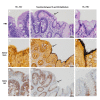Human Intestinal Spirochetosis Incompatible With Dysplastic Adenomatous Epithelium
- PMID: 35444914
- PMCID: PMC9009974
- DOI: 10.7759/cureus.23140
Human Intestinal Spirochetosis Incompatible With Dysplastic Adenomatous Epithelium
Abstract
Human intestinal spirochetosis (HIS) refers to the colonization of spirochetal bacteria in the human intestinal tract. HIS caused by Brachyspira spp. has been recognized for decades, but their pathological and clinical significance is largely unclear. The coincidence of dysplasia in adenoma or adenocarcinoma and HIS is very rare, and whether spirochetes can colonize on dysplastic epithelium remains controversial. Here, we report a case that showed abrupt abolition of mucosal surface fringe formation on a tubular adenoma (TA) and increased cytoplasmic MUC1 expression in the dysplastic epithelial cells compared with adjacent nondysplastic colonocytes. The findings support the hypothesis that the epithelial colonization of spirochetes is significantly reduced by dysplasia likely due to loss of microvilli, and an increase of epithelial MUC1 expression might contribute to reduced spirochetal colonization in colonic mucosa.
Keywords: brachyspira; brachyspira aalborgi; brachyspira pilosicoli; colonic adenoma; human intestinal spirochetosis; intestinal microbiota; muc1; sessile serrated adenoma; sessile serrated lesion; tubular adenoma.
Copyright © 2022, Lilley et al.
Conflict of interest statement
The authors have declared that no competing interests exist.
Figures


References
-
- Distribution and phylogeny of Brachyspira spp. in human intestinal spirochetosis revealed by FISH and 16S rRNA-gene analysis. Rojas P, Petrich A, Schulze J, et al. Anaerobe. 2017;47:25–32. - PubMed
-
- Colonic tubular adenomas and intestinal spirochaetosis: an incompatible association. Coyne JD, Curry A, Purnell P, Haboubi NY. Histopathology. 1995;27:377–379. - PubMed
Publication types
LinkOut - more resources
Full Text Sources
Research Materials
Miscellaneous
